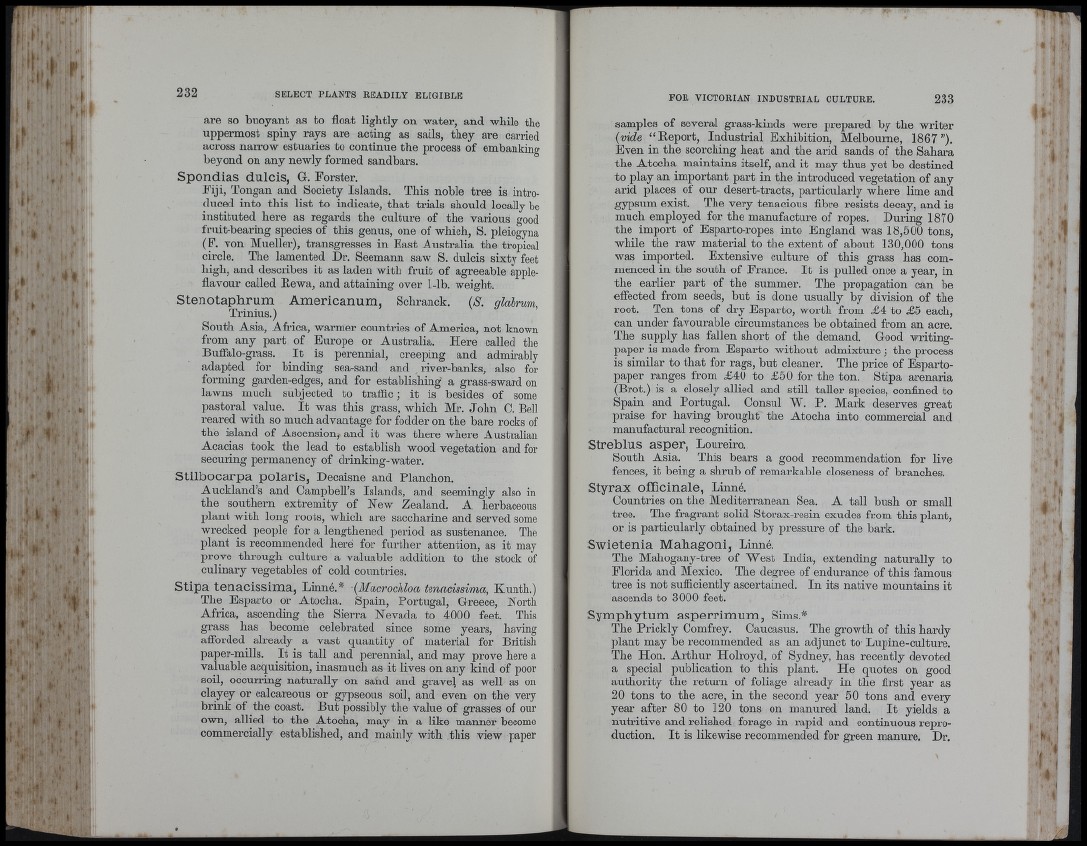
%\
are so buoyant as to float lightly on water, and while the
uppermost spiny rays are acting as sails, they are carried
across narrow estuaries to continue the process of embanking
beyond on any newly formed sandbars.
Spondias dulcis, G. Forster.
Fiji, Tongan and Society Islands. This noble tree is introduced
into this list to indicate, that trials should locally be
instituted here as regards the culture of the various good
fruit-bearing species of this genus, one of which, S. pleiogyna
(F. von Mueller), transgresses in East Australia the tropical
circle. The lamented Dr. Seemann saw S. dulcis sixty feet
high, and describes it as laden with fruit of agreeable apple-
flavour called Eewa, and attaining over 1-lb. weight.
Stenotaphrum Americanum, Schranck. {S. glabrum,
Trinius.)
South Asia, Africa, warmer countries of America, not known
from any part of Europe or Australia. Here called the
Buffalo-grass. I t is perennial, creeping and admirably
adapted for binding sea-sand and river-banks, also for
forming garden-edges, and for establishing a grass-sward on
lawns much subjected to traffic; it is besides of some
pastoral value. I t was this grass, which Mr. John C. Bell
reared with so much advantage for fodder on the bare rocks of
the island of Ascension, and it was there where Australian
Acacias took the lead to establish wood vegetation and for
securing permanency of drinking-water.
Stilbocarpa polaris, Decaisne and Planchon.
Auckland’s and Campbell’s Islands, and seemingly also in
the southern extremity of New Zealand. A herbaceous
plant with long roots, which are saccharine and served some
wrecked people for a lengthened period as sustenance. The
plant is recommended here for further attention, as it may
prove through culture a valuable addition to the stock of
culinary vegetables of cold countries.
Stipa tenacissima, Linné.* -{Macrocliloa tenacissima, Kunth.)
The Esjiarto or Atocha. Spain, Portugal, Greece, North
Africa, ascending the Sierra Nevada to 4000 feet. This
grass has become celebrated since some years, having
afforded already a vast quantity of material for British
paper-mills. I t is tall and perennial, and may prove here a
valuable acquisition, inasmuch as it lives on any kind of poor
soil, occurring naturally on sand and gravel as well as on
clayey or calcareous or gypseous soil, and even on the very
brink of the coast. But possibly the value of grasses of our
own, allied to the Atocha, may in a like manner become
commercially established, and mainly with this view j)aper
samples of several grass-kinds were prepared by the writer
{vide “ Beport, Industrial Exhibition, Melbourne, 1867”).
Even in the scorching heat and the arid sands of the Sahara
the Atocha maintains itself, and it may thus yet be destined
to play an important part in the introduced vegetation of any
arid places of our desert-tracts, particularly where lime and
gypsum exist. The very tenacious fibre resists decay, and is
much employed for the manufacture of ropes. During 1870
the import of Esparto-ropes into England was 18,500 tons,
while the raw material to the extent of about 130,000 tons
was imported. Extensive culture of this grass has commenced
in the south of France. I t is pulled once a year, in
the earlier part of the summer. The propagation can be
effected from seeds, but is done usually hy division of the
root. Ten tons of dry Esparto, worth from £ 4 to £5 each,
can under favourable circumstances be obtained from an acre.
The supply has fallen short of the demand. Good writing-
paper is made from Esparto without admixture ; the process
is similar to that for rags, but cleaner. The price of Esparto-
paper ranges from £40 to £50 for the ton. Stipa arenaria
(Brot.) is a closely allied and still taller species, confined to
Spain and Portugal. Consul W. P. Mark deserves great
praise for having brought the Atocha into commercial and
manufacturai recognition.
Streblus asper, Loureiro.
South Asia. This bears a good recommendation for live
fences, it being a shrub of remarkable closeness of branches.
Styrax officinale, Linné.
Countries on the Mediterranean Sea. A tall hush or small
tree. The fragrant solid Storax-resin exudes from this plant,
or is particularly obtained by pressure of the bark.
Swietenia Mabagoni, Linné.
The Mahogany-tree of West India, extending naturally to
Florida and Mexico. The degree of endurance of this famous
tree is not sufficiently ascertained. In its native mountains it
ascends to 3000 feet.
Symphytum asperrimum, Sims.*
The Prickly Comfrey. Caucasus. The growth of this hai’dy
plant may he recommended as an adjunct to- Lupine-culture.
The Hon. Arthur Holroyd, of Sydney, has recently devoted
a special publication to this plant. He quotes on good
authority the return of foliage already in the first year as
20 tons to the acre, in the second year 50 tons and every
year after 80 to 120 t.ons on manured land. I t yields a
nutritive and relished forage in rapid and continuous reproduction.
I t is likewise recommended for gTeen manure. Dr.
4
fl *
•! i
-Vi',;
: >1 „ iI
! ■ r “ 'I ;
|i,, :♦
iV' ¡
ilV: '